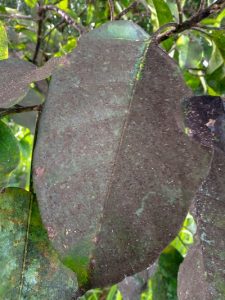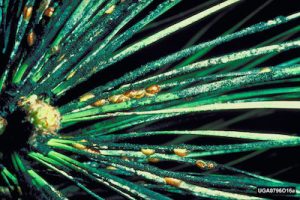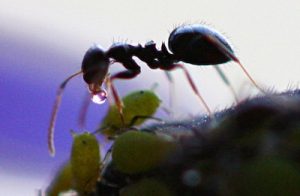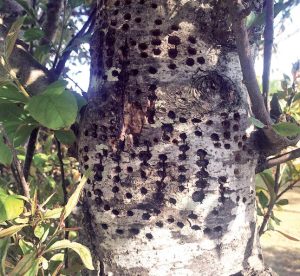Black Sooty Mold Should Trigger Closer Examination
By Ann M. Mason, Fairfax Master Gardener

Black Sooty Mold on a Leaf
Walking through the garden, you might see leaves and fruit covered with a black threadlike growth resembling a layer of soot. Or you might see a black layer on your walkway, rocks or car. What should this observation inspire you to do?
Black sooty mold is a broad term for a group of fungal diseases that coats leaves, fruit and other surfaces with a dark growth. Under a microscope, this growth appears as fine threads called hyphae that intertwine as they grow into a network of threads called mycelium. At the tip of some hyphae, spores will form to allow the fungus to spread by wind, insects and water (rain) expanding the mold to nearby plants and surfaces. Molds grow best in warm, dry weather when air circulation around plants is poor.
Black sooty mold does not invade or grow into the tissue of leaves or tree bark. But allowing the mold to remain on leaves negatively impacts the ability of the sun to reach the leaf surface. Mold blocks the sun and thwarts the ability of the leaf to carry on photosynthesis, which reduces plants’ ability to create glucose, its energy source. If enough leaves are covered with mold, the plant may die.

Black Sooty Mold and Pine Tortoise Scale
Upon seeing black sooty mold on a plant, tree bark, or other surfaces, the gardener’s immediate question is to ask: WHAT is causing this dark sooty stuff?
Seeing black sooty mold should raise the gardener’s curiosity, interest and action because the cause for the mold is the result of a cascading assault on your plant and trees. Careful inspection can locate and identify the source, the first step in controlling any pest.
Black sooty mold usually grows on liquid deposits of sap excreted by piercing sap-sucking insects, such as aphids, psyllids, white flies, leafhoppers, soft scales and mealybugs. Biologists use the term ‘honeydew’ to describe this sweet liquid sap excretion. The analysis of insect honeydew shows that it contains sugars, amino acids, proteins, minerals and vitamins — making it a wonderful substrate for mold growth.

Ant Receiving Honeydew from Aphid
Black sooty mold can attract ants drawn to the sweet honeydew as a food source. To keep this as a food supply, ants protect the piercing sap-sucking insects producing the honeydew from the natural predators. That means the ants attack predators, including wasps that feed on and naturally keep these sap-sucking pests under control.
Gardeners might first search for the typical sap-sucking insect, the usual cause. However, they will also want to consider alternative causes. Foresters have observed that pecking birds, in particular the sapsuckers, prefer certain trees, usually smooth, thin barked trees, such as the sugar maple (Acer saccharum) and members of the birch family, to gain access and feed on sap. In the sapsucker nesting areas, these birds often return again and again to their sap-favored trees. Observing a blackened trunk in a normally grey trunked tree is a trigger for the gardener to look above for the typical linear pecking of neatly spaced horizontal and vertical holes around the circumference of the trunk. While the tree usually survives this pecking, gardeners are advised to monitor the trees for collateral insect activity drawn to the easy entry to tree tissue. Trees with cambium pecking that girdles the truck are stressed and can die from this sustained injury. [Note: Laws protect sapsuckers and woodpeckers from harm. Gardeners wanting to thwart the birds’ pecking should research this more since any measure might shift the birds’ attention to a nearby tree.]

Typical Sapsucker Damage
Virginia Tech and other university experts report that the newest pest villain in the garden is the invasive Spotted Lanternfly (Lycorma delicatula), whose nymphs suck sap out of a wide variety of trees and crops. University experts report the Spotted Lanternfly impacts over 70 plants, including grapes, pines, stone fruit trees, a wide variety of hardwood trees and more. At the time of this article, random hitchhikers have been observed in Fairfax County and fortunately, we do not have a confirmed infestation in our Fairfax County area. Armed with this information, gardeners might keep this possible source in mind as they look for the cause of future cases of black sooty mold, especially if the Spotted Lanternfly’s preferred host plant, the Tree of Heaven (Alianthus altissima), is in the vicinity of their garden.
New research reports that the leaves of some plants, such as Catalpa, Hibiscus, and black walnut (Juglans nigra), can exude a sweet substance from a growth in the epidermal leaf tissue called glandular trichomes. Research is underway to better understand this tissue and the substances it exudes. So, gardeners might see black sooty mold on leaves of these plants without seeing insect or bird populations.
Thus, black sooty mold is a symptom that the gardener might have a pest above the infected area in the garden. University experts do not recommend any chemical control for black sooty mold. If the gardener can use warm water to wash the sticky mold off the leaf surface, the leaf might be saved. Otherwise, experts suggest removing mold covered leaves and stems and disposing them in the trash (not compost). Note: some soaps and detergents can scorch the leaf. For black sooty mold on tree bark and stems, the experts recommend washing them, but because of the sticky nature of molds, growth can return if conditions allow regrowth. Experts recommend gardeners undertake selective pruning to remove dead and dying tree branches to limit the insects and prevent insect spread.
While black sooty mold is unsightly, the gardener will want to find and identify the cause and use appropriate methods to control the source of the sweet substrate that allows mold growth. To control aphids, psyllids, white flies, leafhoppers and mealybugs, university experts recommend using a strong stream of water to knock sap-sucking insects off plants, particularly on tender new growth. Some infestations might need chemical treatment. Soft scales need to be treated during the crawler stage. Gardeners will want to consult the current version of the Virginia Cooperative Extension’s Pest Management Guide for appropriate chemical controls and timing. In addition, working to keep plants stress-free and healthy also makes the plant less attractive to these sap-sucking insects.
Controlling ants with ant baits or sticky tape around trees and shrubs allows the predator and parasite population to resume their work to remove the piercing sap-sucking insects.
When gardeners see black sooty mold on trees, plants, and surfaces, it is a call to action. Identification of the source of the honeydew is needed to prevent the insects or animals from severely harming or even killing plants in the garden.
Resources
• Spotted Lanternfly (Lycorma delicatula), Virginia Cooperative Extension Publication ENTO-180NP
• Sooty Mold Fact Sheet, Dan Gillman, Center for Agriculture, Food and the Environment, UMass
Extension
• Sooty Mold of Conifers and Hardwoods, Forest Tree Diseases of Virginia, Virginia Tech
• Black Bark as an Indicator of Bird Peck Defect in Sugar Maple, US Forest Service Research Paper LS-14,
Lake States Forest Experiment Station, US Department of Agriculture
• Sooty Molds, Steven Frank, Stephen Bambara, RK Jones, James Baker, NC State Extension
• Sooty Mold, Karey Windbiel-Rojas and Belinda Messenger-Sikes, Pests in Gardens and Landscapes,
University of California Integrated Pest Management Program
• instructional video on using a sticky barrier The University of California posts an instructional video on
using a sticky barrier to prevent ants on trees and shrubs.
• Plant Glandular Trichomes: Natural Cell Factories of High Biotechnological Interest, Huchelmann A.,
et al, Plant Physiology, Volume 175